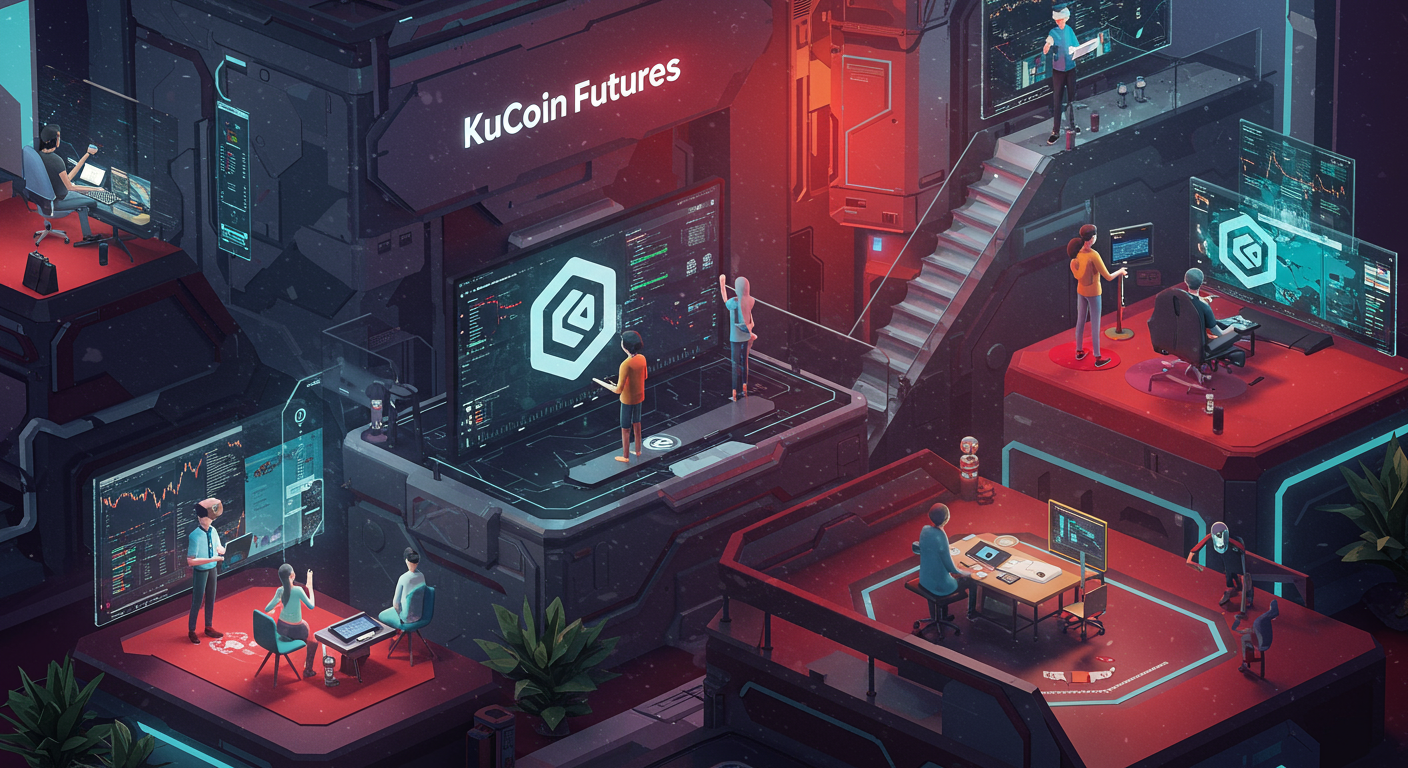Fueling the Future: A Deep Dive into KuCoin Futures’ $10 Million Web3 Ecosystem and Affiliate Initiative
John: Welcome back to the blog, everyone. Today, we’re tackling a topic that sits right at the intersection of crypto finance, community building, and the future of the decentralized internet. KuCoin, a name familiar to most in the crypto space, has made a significant move through its derivatives platform, KuCoin Futures. They’ve announced a substantial $10 million initiative designed to reshape their affiliate program and bolster the wider Web3 ecosystem. It’s a major capital injection, and it signals a strategic shift that’s worth examining closely.
Lila: A $10 million initiative—that definitely catches the ear. So, John, this isn’t just about offering better referral bonuses, is it? When I see a number that big, I think it has to be about more than just getting new users to sign up for futures trading. The term “Web3 ecosystem” suggests a much broader ambition.
John: That’s exactly the right question to ask, Lila. You’ve hit the nail on the head. This initiative is a multi-faceted strategy. While enhancing their affiliate program is a core component, the plan explicitly includes nurturing Web3 innovators and strengthening community engagement. It’s a move from a purely transactional relationship with partners to a more collaborative, growth-oriented one. They’re not just buying traffic; they’re investing in the infrastructure—both human and technical—that they believe will support their platform for years to come.
Lila: Investing in human infrastructure… I like that. It sounds less like a marketing campaign and more like an incubator or a grant program. It feels very much in the spirit of Web3, where value is created and shared within a community rather than just extracted by a central entity. Let’s break it down for our readers who might be new to these concepts.

Basic Information: What is the $10 Million Initiative?
John: At its core, the KuCoin Futures $10 Million Initiative is a dedicated fund announced by the platform to empower its partners. The official press releases state that this capital will be deployed to achieve three primary goals: first, to significantly empower their global network of affiliates; second, to nurture the next generation of Web3 talent and innovation; and third, to enhance overall community engagement. It’s a commitment to pour resources back into the ecosystem that supports their business.
Lila: Okay, so let’s clarify what “KuCoin Futures” is for any beginners. We know KuCoin is a major cryptocurrency exchange, like a stock market for digital assets. So, “Futures” is their platform for a specific type of trading, right?
John: Correct. KuCoin Futures is the derivatives trading arm of the exchange. It allows users to trade futures contracts, which are agreements to buy or sell a specific cryptocurrency at a predetermined price at a specified time in the future. It’s a more advanced form of trading that involves leverage (borrowing funds to increase a trading position) and is used by traders to speculate on market direction or hedge (protect against) their existing positions. It’s a high-volume, high-stakes part of the crypto world, which is why user acquisition and education are so critical for them.
Lila: That makes sense. And an “affiliate” in this context is essentially a partner—maybe a content creator, a popular trader on social media, or a crypto news website—who promotes KuCoin Futures and earns a commission when their followers sign up and trade?
John: Precisely. Affiliate marketing is a cornerstone of user growth for nearly every crypto exchange. This initiative, however, aims to elevate that model. Instead of just a simple commission, they’re talking about creating “Million-Dollar Star Partners,” which implies a much deeper level of support, collaboration, and earning potential.
Supply Details: Deconstructing the $10 Million Fund
Lila: Let’s talk about the money itself. Is KuCoin dropping the full $10 million on day one, or is this a long-term commitment? The structure of the funding often tells you a lot about the goal.
John: That’s an astute observation. This isn’t a one-time lump sum. The plan, as outlined in their announcements, is to invest $1 million per month. This sustained, monthly deployment is significant. It suggests a long-term strategy rather than a short-term marketing blitz. It allows them to be agile, to learn what works, and to consistently support the community over an extended period. A monthly budget provides stability for partners and for the projects they decide to back.
Lila: A million dollars a month is still a huge amount. Where does it all go? Can we break down the allocation? Is it 50% for affiliate commissions, 30% for grants, or is it more fluid than that?
John: The public statements don’t give a rigid percentage breakdown, which is likely intentional to maintain flexibility. However, we can infer the primary buckets of spending from their goals. A significant portion will undoubtedly go towards direct affiliate compensation. This could include higher commission rates, performance-based bonuses, and exclusive airdrops (free distributions of tokens) for top-performing affiliates and their communities.
Lila: So, better rewards for the people bringing in new traders. That’s straightforward. What about the “nurturing innovators” part? That sounds more abstract.
John: That’s where it gets interesting and moves into the realm of a true ecosystem fund. This portion of the monthly budget is likely earmarked for:
- Educational Resources: Funding the creation of high-quality tutorials, webinars, and market analysis content, potentially co-created with their star affiliates. This helps onboard new users more safely and effectively.
- Grants for Web3 Projects: Providing seed funding or technical support to developers and startups building new tools, dApps (decentralized applications), or platforms that could integrate with or benefit the KuCoin ecosystem.
- Community Events: Sponsoring hackathons, online competitions, and local meetups to foster a sense of community and spur creative development.
- Technology Incubation: Supporting projects that are exploring the frontiers of Web3, whether in DeFi (Decentralized Finance), NFTs (Non-Fungible Tokens), or even Metaverse integrations.
Lila: So, an affiliate who is also a developer could potentially get a commission for referring users *and* a grant to build a new trading analysis tool for the community? That creates a powerful incentive loop.
John: Exactly. It aligns the incentives of creators, builders, and the platform itself. When the ecosystem grows, everyone benefits. That’s the foundational philosophy of Web3 in action, even when initiated by a centralized company.
Technical Mechanism: How Does It All Work?
Lila: Let’s get into the nitty-gritty. If I’m a YouTuber with a channel about crypto, how do I actually participate in this? What does the technical side of the affiliate program look like?
John: From a technical standpoint, it starts with the classic affiliate model. A potential partner applies to the KuCoin Futures Affiliate Program. Once approved, they receive a unique referral link or code. They then share this link in their content—videos, articles, social media posts. When a new user clicks that link, signs up for a KuCoin account, and starts trading on the Futures platform, a tracking cookie attributes that user to the affiliate.
Lila: And the affiliate gets a cut of the trading fees that user generates?
John: Correct. The core mechanism is a commission based on a percentage of the trading fees. These are often called rebates. For example, an affiliate might earn a 40% or 50% commission on the fees generated by their referrals. What this new initiative likely adds are tiered bonuses. The more trading volume an affiliate’s referrals generate, the higher their commission percentage might climb. On top of that, there are special campaigns, like the token airdrops we mentioned, where affiliates can earn extra rewards in cryptocurrencies like USDT (a stablecoin pegged to the US dollar) for hitting certain milestones.
Lila: So there’s a dashboard where an affiliate can track their clicks, sign-ups, and earnings in real-time?
John: Yes, a robust affiliate dashboard is crucial. It provides transparency and allows partners to see what’s working. They can monitor their performance, track commissions, and access marketing materials provided by KuCoin. The technical upgrade as part of this initiative would likely involve enhancing this dashboard with more detailed analytics and growth tools, helping affiliates optimize their strategies.

Lila: And what about the Web3 ecosystem support? How is that facilitated technically? Is it just a bank transfer, or is it more integrated?
John: That’s a more complex process. For projects seeking grants, there would be a formal application process. A team would submit a proposal outlining their idea, their team, their roadmap, and how their project would benefit the KuCoin ecosystem. The technical part here involves due diligence—KuCoin’s team would need to evaluate the technical feasibility of the project, audit its code for security, and assess its potential impact. Funding would likely be delivered in stages via cryptocurrency (like USDT or KuCoin’s own KCS token) to a project’s treasury wallet, contingent on them meeting development milestones.
Team & Community: The People Behind the Push
Lila: This is a massive strategic pivot. Who are the key people at KuCoin driving this vision? And what kind of community are they trying to build? It can’t just be for the high-rolling “crypto bro” traders.
John: While specific individuals leading the charge are often within the executive team of KuCoin Futures, the vision is articulated by the CEO of KuCoin, Johnny Lyu, and the leadership of the Futures division. Their public statements emphasize a long-term perspective. They see that the next wave of crypto adoption won’t come from just offering another trading product. It will come from building sticky, engaged communities where users feel they are part of something bigger. The community they are targeting is deliberately diverse.
Lila: So, who’s in this target community?
John: It’s a wide net.
- Content Creators & Educators: The YouTubers, bloggers, and Twitter personalities who can break down complex topics like futures trading for a mass audience. This initiative aims to turn them into well-compensated, long-term partners.
- Community Managers: Individuals who run large Telegram or Discord groups. KuCoin wants to empower them with tools and rewards to keep their communities active and informed.
- Technical Analysts: Skilled traders who share market insights. The platform can give them a bigger stage and a way to monetize their expertise.
- Web3 Developers: The builders. By offering grants and support, KuCoin is trying to attract talent that can build the next generation of financial tools on top of or alongside their platform.
The “Million-Dollar Star Partners” program is the pinnacle of this. It’s about identifying the most impactful partners and giving them bespoke support, almost like a talent management agency would, to help them grow their brand and earnings to the highest level.
Lila: It’s fascinating because it feels like a move to professionalize the role of a crypto “influencer,” transforming it from a simple referral gig into a genuine career path with substantial backing. It’s about creating a guild of evangelists and builders who are deeply integrated with the platform.
John: That’s a perfect way to put it. They are fostering a professional class of ecosystem participants. And by doing so, they hope to build a powerful “moat”—a competitive advantage that’s difficult for others to replicate because it’s based on human relationships and a shared community identity, not just technology.
Use-Cases & Future Outlook: What Does Success Look Like?
Lila: So, fast-forward a year or two. If this initiative is successful, what will have changed? What are the tangible use-cases and what does the future look like for KuCoin and its community?
John: In the short term, the primary use case is clear: a more vibrant and rewarding affiliate program. For affiliates, it’s a chance to earn significant, potentially life-changing income. For new users, it means access to better educational content and communities to help them navigate the complexities of futures trading. But the long-term outlook is far more ambitious.
Lila: Paint me a picture of that ambitious future.
John: Success, in the long run, would look like this:
- A Self-Sustaining Ecosystem: The initiative seeds a network of content creators and developers that continues to grow organically. New users are onboarded through high-quality, community-led education, reducing the platform’s reliance on traditional advertising.
- A Hub of Innovation: The grant program successfully launches several new, innovative Web3 projects. These might be new analytics dashboards, automated trading bots, decentralized portfolio management tools, or even gaming platforms that integrate with KuCoin’s financial infrastructure.
- Increased Market Share and Resilience: KuCoin Futures solidifies its position as a top-tier derivatives platform, not just because of its technology, but because of its deeply loyal and engaged community. This makes it more resilient to market downturns, as the community provides a stable foundation.
- A Bridge to the Metaverse: Looking even further ahead, this ecosystem could become a foundational economic layer for Metaverse applications. Imagine in-game economies where assets can be seamlessly traded on KuCoin Futures, or virtual educational institutions, funded by this initiative, teaching Web3 finance inside a virtual world.
The ultimate goal is to transition from being just a tool (a trading platform) to being an environment—a rich, interactive ecosystem where users come to learn, earn, build, and connect.
Lila: That “environment” concept is really powerful. It reminds me of how Apple built a moat not just with the iPhone, but with the App Store. The value is in the ecosystem that is built on top of the core product. It seems KuCoin is trying to build its own version of that for the Web3 world.

Competitor Comparison: How Does This Stack Up?
Lila: Okay, let’s be realistic. KuCoin isn’t the only exchange in the sea. How does this $10 million plan compare to what the other giants like Binance, Bybit, or OKX are doing? Don’t they all have huge affiliate programs?
John: They absolutely do, and that’s what makes this announcement so noteworthy. Affiliate programs are table stakes in this industry. Binance, for example, has an enormous and highly effective affiliate network. However, the differentiation here lies in the framing and the scale of the dedicated fund.
- Binance: Their program is massive and offers high commission rates. They focus heavily on rewarding high-volume referrers. While they have Binance Labs for investing in projects, this KuCoin initiative seems to more tightly integrate the affiliate and ecosystem-building efforts under one umbrella.
- Bybit: Bybit is also known for a very strong affiliate and influencer marketing game. They are very active in community engagement. The key difference with KuCoin’s move is the public declaration of a specific, large-scale fund ($10M) dedicated to this purpose, which serves as a powerful marketing and recruitment statement.
- OKX: OKX also has a competitive affiliate program and is making major investments in its own public blockchain and Web3 wallet. Their strategy is perhaps more focused on building their own walled-garden technical stack. KuCoin’s approach seems more focused on empowering a wider, more diverse range of external partners and creators.
So, while the core activity—rewarding referrals—is similar, KuCoin is making a statement by publicly ring-fencing $10 million and explicitly labeling it as a fund for both affiliates *and* Web3 ecosystem development. It’s a strategic communication move as much as a financial one, designed to attract the very best partners who want more than just a commission check.
Lila: So it’s less about having a unique feature and more about the unique commitment and the holistic vision of combining affiliates with ecosystem grants in such a public way?
John: Exactly. It signals that they view their partners not just as a sales channel, but as a strategic asset worth a massive, long-term investment.
Risks & Cautions: What Could Go Wrong?
Lila: This all sounds incredibly optimistic. As a journalist, I have to ask: what are the potential downsides and risks? What’s the catch for affiliates and for the platform itself?
John: An essential question. No plan, no matter how well-funded, is without risk. For participants and the company, the main cautions are:
- Execution Risk: Announcing $10 million is easy. Deploying it effectively is hard. The success of the initiative hinges entirely on the KuCoin Futures team’s ability to identify and support the right partners and projects. If they mismanage the funds or the selection process is poor, it could all amount to very expensive marketing with little long-term impact.
- Market Dependency: Affiliate earnings are directly tied to trading activity. In a prolonged bear market (a period of falling prices), trading volumes can plummet. This would drastically reduce earnings for affiliates, regardless of the program’s structure. The $10M fund might buffer this, but it can’t defy market gravity forever.
- Regulatory Scrutiny: Derivatives trading and crypto affiliate marketing are both areas that attract attention from regulators worldwide. Partners, especially those in jurisdictions with unclear crypto laws, need to be aware of the potential compliance risks.
- Centralization vs. Decentralization: This is a classic Web3 dilemma. While the initiative uses the language of decentralization and ecosystem, it is ultimately controlled and funded by a centralized exchange. The projects and partners they choose to fund will inevitably be those that align with KuCoin’s strategic interests. It’s empowerment, but within a framework defined by the company.
- Quality Control: Empowering a huge network of affiliates also risks the proliferation of low-quality or hyped-up content. KuCoin will need to maintain a balance between encouraging promotion and ensuring their partners are acting responsibly and not misleading new users about the risks of futures trading.
Lila: That last point is really important. With great earning potential comes a great responsibility to be honest with your audience, especially when it comes to high-risk products like leveraged futures.
Expert Opinions & Analyses
John: Looking at the initial industry reaction, the sentiment is broadly positive. Most news outlets and analysts, as seen in the press releases from sources like PR Newswire and FinanceFeeds, have reported the announcement as a sign of KuCoin’s strength and commitment to growth. The narrative is that KuCoin is proactively investing in its community to build a sustainable competitive advantage.
Lila: Has anyone offered a more critical or cynical take?
John: Of course. The more cynical view, often whispered in crypto circles rather than published, is that this is a brilliantly packaged marketing campaign. The argument is that the “Web3 ecosystem” label is a trendy wrapper for what is, essentially, a very large budget to acquire users for their most profitable product. Skeptics would say that the true test will be the output. In a year, we need to ask: Was the money primarily used to pay out higher rebates, or did it genuinely foster new, independent, and innovative projects? The answer will reveal the true nature of the initiative.
Lila: So the jury is still out. The promise is huge, but the proof will be in the execution.
John: Precisely. It’s a story we’ll have to follow closely.
Latest News & Roadmap
Lila: So what’s the very latest on this? And what should we be looking for on the roadmap?
John: The latest news is the launch itself. The initiative has just been unveiled, so we’re at the starting line. The immediate roadmap is the monthly deployment of the $1 million fund. Key milestones to watch for in the coming months will be:
- The announcement of the first “Million-Dollar Star Partners.” Seeing who they choose to elevate will say a lot about their priorities.
- The launch of new, co-branded educational campaigns. This will be the first tangible output of the community engagement pillar.
- The first cohort of grant recipients. The types of Web3 projects they choose to fund will be a major indicator of their long-term vision.
- Updates to the affiliate platform. We should expect to see new tools and features rolling out for partners on their dashboards.
For now, the main action is the recruitment drive, as KuCoin is actively encouraging potential partners to apply and join the program.
Frequently Asked Questions (FAQ)
What is the KuCoin Futures $10M Initiative?
Lila: So, to sum it up for someone who just skimmed to the bottom, what is this initiative in one sentence?
John: It’s a long-term, $10 million fund from KuCoin Futures, deployed at $1 million per month, to aggressively grow its affiliate program, provide grants to new Web3 projects, and build a more engaged and educated trading community.
Who is eligible to become an affiliate?
Lila: Can anyone with a social media account join?
John: Generally, they look for partners who already have an established community or platform related to cryptocurrency. This includes content creators (YouTubers, bloggers), social media influencers, community managers (of Telegram/Discord groups), and websites. While there might not be a strict follower minimum, they are looking for individuals or organizations that can genuinely reach and influence a relevant audience.
How much can an affiliate actually earn?
Lila: We’ve heard the phrase “Million-Dollar Star Partners,” but what’s a realistic expectation for earnings?
John: It varies dramatically. A small affiliate might earn a few hundred dollars a month. A successful, mid-tier partner could earn several thousand or tens of thousands. The “Million-Dollar” title refers to the potential total value for top-tier partners, which likely includes not just their direct commissions over time, but also the value of special bonuses, airdrops, and co-marketing support. It’s an aspirational goal, but the commission rates (often 40-60%) mean that referring active, high-volume traders can be extremely lucrative.
What does “Web3 ecosystem support” actually mean?
Lila: Is it just a buzzword, or is there substance to it?
John: In this context, it’s more than a buzzword. It means dedicating a portion of that $1 million monthly budget to activities that build up the broader space. This includes funding new decentralized applications (dApps), providing technical support to developers, sponsoring educational content, and running events like hackathons that spur innovation beyond KuCoin’s own platform.
Is this initiative related to the Metaverse?
Lila: We’re a Metaverse blog, so I have to ask: where does the Metaverse fit in?
John: The link is forward-looking but direct. A robust Web3 ecosystem, with strong financial primitives (like derivatives), educated users, and a network of creators, is a fundamental building block for the Metaverse. As virtual worlds develop their own economies, they will need to connect to powerful, liquid financial platforms. By building this community and infrastructure now, KuCoin is positioning itself to be a key financial service provider for the economies of the Metaverse in the future.
Related Links
John: For our readers who want to dive deeper or even apply to the program, the best place to start is with the official sources.
Lila: We’ll link them here so you can do your own research.
- KuCoin Official News Announcements
- KuCoin Futures Affiliate Program Page
- KuCoin Official X (Twitter) Account for the latest updates.
John: This is a significant development in the crypto exchange landscape. It’s a bold investment in the power of community and a clear bet on a future where platforms thrive by building ecosystems, not just products. It will be fascinating to watch this $10 million seed grow.
Lila: Absolutely. A story of community, crypto, and a whole lot of capital. We’ll definitely keep our readers updated as it unfolds. Thanks, John.
John: My pleasure, Lila.
Disclaimer: This article is for informational and educational purposes only. It is not financial advice. The cryptocurrency market, and especially futures trading, is highly volatile and carries significant risk. Always do your own research (DYOR) before making any investment decisions.
